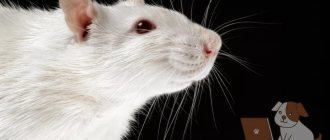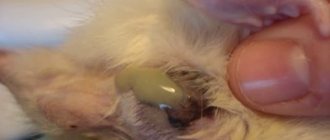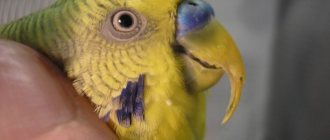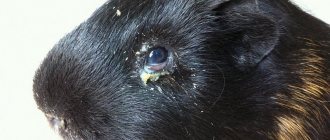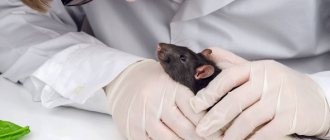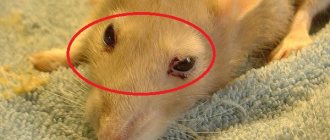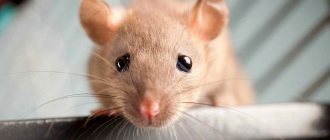- Neoplasms in internal organs
- Breast tumors
- Neoplasms on the skin, tumors of the subcutaneous tissue and bones
- Bone neoplasms
- What to look for
- How to reduce the risk of tumor development in your animal:
Decorative rats and pet hamsters live on average about two years in captivity.
Some absolutely healthy animals rarely live up to three years. The lifespan of a rodent is influenced by many factors, including heredity, care, balanced nutrition, and disease prevention. The older the rat or hamster, the greater the likelihood that the animal will develop a tumor of one kind or another. The cause of death for almost every mature rat at home is a malignant neoplasm.
The prerequisites for the development of tumors are bruises, falls, poor nutrition, and irregular sex life of our animals, which, naturally, is the result of keeping a rodent at home, because in nature, female rats can give up to eight litters a year, and hamsters - up to four.
Rodent tumors are divided into benign and malignant.
Benign tumors develop quickly in the body, but unlike malignant tumors, they do not metastasize, that is, they do not spread to other parts of the body. Typically, such tumors do not cause the death of the animal, but in advanced cases they grow to such an extent that it can no longer take care of itself normally. Benign tumors are almost always easy to remove surgically, and therefore the prognosis in this case is favorable.
Malignant tumors or cancer metastasize to adjacent tissues and organs. In small animals such as rats and hamsters, cancer in most cases affects the internal organs, and surgery becomes impossible. In this case, the animal lives out its life or, in advanced cases, it has to be euthanized.
Types of tumor
Among all the neoplasms found in decorative rats, veterinarians distinguish 2 main types:
- Benign . They have a favorable prognosis for recovery. The outside of the tumor is covered with connective tissue, which prevents contact with healthy tissues and organs. Treatment is carried out only surgically under general anesthesia. The sooner the tumor is removed, the better. As benign tumors grow, they strongly compress the internal organs, preventing their normal functioning.
- Malignant . They are characterized by rapid growth, damage to healthy cells, and the appearance of numerous metastases. There is no use in treating cancer in rodents. Usually the fluffy is prescribed maintenance therapy and sent home to live out his last days.
Rats with cancer experience excruciating pain. Therefore, for reasons of humanity, ratologists often recommend euthanizing the animal after making a terrible diagnosis.
Rat cancer - what is it?
Malignant tumors are cancer. Typically, such tumors are more aggressive in their behavior as they invade and damage nearby tissues. This form of malignant cancer can also spread to other parts of the body. Death may result from failure of damaged organs or mechanical interference with normal functions such as eating. Symptoms of this form of cancer may include ulceration of the skin, an infected tumor or abscess that does not heal, an ulcerated or bleeding tumor, bloating, weight loss, or lethargy.
In some cases, cancer may appear on internal organs. Therefore, symptoms may not appear until the disease progresses to the point where treatment is ineffective. This is one reason why it is important for owners to perform weekly health checks on their rats at home and keep in touch with veterinarians.
Causes of tumor
Both decorative and wild rats are predisposed to the development of neoplasms at the genetic level. However, there are several additional reasons that can provoke the disease:
- frequent nervous shocks;
- absence of childbirth and breastfeeding throughout life in females;
- sedentary lifestyle;
- poor quality nutrition, consumption of foods containing GMOs, dyes, flavors, preservatives;
- mycoplasmosis;
- bad ecology.
It was also found that neoplasms of both types more often affect rats aged 2-3 years. While young animals rarely encounter cancer. You can read how to find out the age of a rat here.
Signs and symptoms
The sooner you start treating your rat, the more likely it is that your pet will be able to return to normal life. Therefore, all rodent owners need to know the symptoms of tumor development. The main manifestations of neoplasms in a pet’s body include:
- the appearance of hernias;
- the animal goes to the toilet too often (big and small);
- discharge of blood from the mouth, nose, anus, vagina;
- severe hair loss, up to complete baldness;
- mucous membranes acquire a grayish tint;
- when palpating the skin on the tips of the fingers, irregularities and tubercles are felt;
- decreased appetite.
Also, when any type of tumor appears, the general well-being of the animal worsens. The rat becomes apathetic, loses interest in everything, and often retreats into the house or hides in a corner.
Coming out of anesthesia
The owner can be with the rat as it begins to recover from the anesthesia. Just don't be afraid of its consequences. You need to be prepared for them:
- The rat is vomiting.
- She goes to the toilet on her own. Bowel movements are involuntary.
- The animal becomes aggressive, this is associated with painful sensations.
- Loss of coordination occurs. The rat moves as if in slow motion.
During recovery from anesthesia, be sure to provide your pet with access to drinking water. Many pets become thirsty during this period.
It is necessary to place a clean diaper under the animal. And change it when it gets dirty.
Sites of tumor origin
Rat breeders need to carefully examine and palpate the entire body of the animal at least once every 6 months. Since tumors in rats can be localized in different places.
Neck
Lumps on the neck can occur as a result of enlarged lymph nodes, suppuration, or a tumor of the thyroid gland. It is not possible to independently determine the cause and type of tumor. To make a diagnosis, you will need to consult a veterinarian.
In the limb area
Lumps under the paws can reach enormous sizes, preventing the pet from moving normally. There are cases where a rat was completely unable to walk. Typically, tumors localized near the extremities are inflamed lymph nodes, wen or breast cancer.
On the cheek
A lump on the cheek can appear both externally and internally. In the first case, it is possible to detect the problem and begin treatment at the initial stages of the disease. If the problem appears inside the oral cavity, the owner learns about the disease only after the tumor has grown strongly. Most often, in the presence of neoplasms on the rat's cheek, cancer is diagnosed - squamous cell carcinoma.
Mammary gland
Traditionally, breast cancer is considered a disease of females. However, occasionally the disease is diagnosed in males.
As a rule, neoplasms in the mammary glands are benign. In this case, the seals have clear outlines upon palpation and easily slip out of the fingers. If the detected ball is firmly attached to the skin and other surrounding tissues, the tumor is most likely malignant.
In nulliparous rats and females who gave birth for the first time over the age of 8 months, the risk of mammary cancer increases by 50% compared to pets who became mothers in the period from 2 to 6 months.
Under the tail
If lumps have formed under the rodent's tail, the pet will most likely be diagnosed with a tumor of the skin or subcutaneous fat. At the same time, small balls can be easily felt in the area of the fluffy’s genitals. In this case, the rat requires urgent surgery.
Brain
When tumors appear in the brain, there are often no external manifestations of the disease. You can suspect the development of the disease by the pet’s behavior: the rat suddenly becomes aggressive, stops responding to sounds, and the animal has problems moving and orienting itself in space. Often brain tumors are benign, but they are not operated on.
On the side
If a rat has a lump on any of its sides, it can be assumed that the rodent will develop cancer of the internal organs - lungs, stomach, liver, kidneys. Since the size of rats is very small, the cause of the tumor can be identified only in a veterinary clinic.
Bones
Rats often suffer from malignant neoplasms that affect bone tissue. The growths are usually localized on the front and hind legs, skull, and ribs. In the initial stages it is impossible to see them with the naked eye. After the tumors grow, the animal gradually loses the ability to move.
Stomach
Quite often, small round lumps can be felt in the lower abdomen of rats. These are usually benign tumors – fibromas. They are fairly easy to treat and have a favorable prognosis. The main thing is to take the fluffy one to the veterinary clinic before the seals grow to gigantic proportions.
Back
Neoplasms that grow on the back of rats usually affect only the upper layers of the skin. Most often, such tumors are benign. But surgical treatment when the lump is localized on the back is not recommended.
The danger lies in the proximity of the spinal column, which can be affected during surgery even by an experienced specialist. In such cases, conservative treatment is indicated for the animal.
Bone neoplasms
A common bone disease in rats and mice is osteosarcoma. If the limbs are damaged, the animal stops actively moving and may even stop standing on its feet. When the skull and ribs are affected, a dense thickening on the bone is clearly palpable upon palpation. Osteoma can easily be confused with a bruise or arthritis, so the veterinarian makes a final diagnosis only after studying the results of cytology and x-rays of the affected area.
Treatment
Treatment of skin tumors and neoplasms of subcutaneous tissue is carried out exclusively by surgery. Timely contact with a specialist increases the animal’s chances of a complete cure. Osteosarcoma is a serious disease; most rodents cope poorly with it and die within six months.
Tumor treatment
Treatment for cancerous tumors in furry animals is not provided, since in rodents such pathologies are detected already at advanced stages, when metastases have spread throughout all tissues.
In such a situation, surgical intervention does not make sense - almost every organ will have to be operated on. The body of a small animal simply cannot withstand such a huge load.
Benign tumors in rats are usually treated with surgery. Only in some cases is surgery contraindicated for an animal:
- old age – over 3 years;
- a tumor has formed in the brain;
- the pet’s body is greatly weakened;
- the pet has additional diagnoses.
If it is impossible to perform surgery to treat benign tumors, the rat is prescribed conservative treatment. However, the chances of the animal’s recovery are extremely low.
Removal operation
When treating benign tumors, the animal has a good chance of survival and a favorable prognosis for a full recovery. Operating on such a small animal is difficult work. The operation to remove a tumor is conventionally divided into several stages:
- Anamnesis collection . The veterinarian examines a small patient, assesses his general condition, and palpates the tumor. The rat is also prescribed additional diagnostic measures - laboratory tests of blood and urine, chest x-ray.
- Anesthesia . Since the operation is performed under general anesthesia, the furry cat is first given medications that support the functioning of the heart muscle and lungs. After which an analgesic is administered. The operation is performed by a veterinarian.
- Removing the seal . If the tumor is located close to the skin and is small in size, the specialist makes a small incision and excises the tissue around the lump. After which, it is removed from the rodent’s body with surrounding intact tissues. The doctor also blocks the functioning of the vessels that fed the removed tumor. If it is necessary to treat a large tumor, in rare cases it is necessary to remove adjacent affected parts of the body, glands or muscles.
- Stitching . Internal sutures are applied using special absorbable threads. The skin is sewn up with the finest silk threads. To drain fluid released from the wound, the doctor leaves a drain.
Depending on the size of the tumor and its location, the duration of surgical intervention varies from 30-40 minutes to 2-3 hours. The rat may feel unwell for 1-2 hours after the operation is completed. The animal often develops vomiting, diarrhea, disorientation in space, and unreasonable aggression.
Until the pet’s health returns to normal, it is necessary to put it on a disposable diaper, which is changed as it gets dirty. You also need to give your fluffy plenty of fluids to drink.
Post-operative care
Your pet will require special care until the wounds heal completely after surgery. In order for the rat to recover faster, you need to create the most comfortable conditions for it:
- Move him away from other rats into the next cage. This is very important, since relatives may accidentally touch the still fresh wounds of the operated animal.
- In the first 3-4 days after surgery, you will need to completely exclude fermented milk products from the rodent’s menu.
- Ensure complete peace in the room in which the cage with the sick animal is located. The light in the room should be dim; it is better to completely curtain the windows. You also need to exclude extraneous noise, loud sounds, and the entry of a domestic cat or dog. There should be no drafts in the room.
- The rat will need warmth for 1-2 days after surgery. Therefore, it is recommended to make a heating pad from available materials. For example, from a plastic bottle. It is necessary to ensure that the water does not have time to cool and is always warm (but not hot).
- The rat should not be allowed to try to lick its wounds on its own. Until the stitches are completely absorbed, the animal must walk in a collar or postoperative blanket.
- Typically, wounds in rats heal quickly without outside intervention. However, if healing takes a long time or suppuration appears, it is better to contact a veterinary clinic. The specialist will process the seams, and will also show and explain to the owner how to do it himself. Most often, brilliant green or special ointments that stimulate tissue regeneration are used to treat postoperative wounds in rats. For example, Levomekol, Ichthyol ointment, Bepanten.
If during the rehabilitation period the rat suddenly feels worse - behaves strangely, refuses to eat and drink, you must immediately show the animal to a ratologist. Because complications cannot be ruled out after surgery.
What should you be wary of?
An attentive owner should be alert and take the pet to a veterinary clinic for timely treatment if the following symptoms are detected:
- soft flat bumps or hard bumpy growths on the animal’s body;
- lethargy, loss of appetite and weight, exhaustion;
- the animal does not play, tries to hide;
- the fur is tousled, there are patches of baldness;
- the skin loses elasticity and scabs appear;
- increase or decrease in bowel movements and urination;
- bloody discharge from the mouth, urethra, vagina and anus;
- hernias;
- mucous membranes are colored gray.
The final diagnosis is made by a veterinarian after a general examination of the animal, laboratory tests of general and biochemical blood tests, and the nature of the tumor is determined histologically.
Preventive measures
A tumor in a rat is not only a cause of severe pain and discomfort for the animal. Treatment of oncology in a pet is a real stress for a loving owner. To protect your furry from illness, tedious trips to the veterinary clinic and surgery, it is better to try to prevent the development of pathology. The main preventive measures include:
- Organizing a balanced diet for your pet . Moreover, it is necessary to provide the animal with proper nutrition from the first days of life. First of all, during feeding you need to exclude products containing harmful chemical compounds (dyes, preservatives, food additives). You will also need to diversify the rat’s daily menu with fresh fruits, berries, vegetables, lean meat, fish, seafood, and low-fat dairy products.
- Maintaining the animal's immune system . Most diseases, including cancer, develop against a background of weakened immunity. Therefore, every day you need to add a little specialized vitamin and mineral complexes to your food feeder to improve the health of rodents. For example, Shustrik, Farmavit Neo, Doctor ZOO, Calcium-D Myshild.
- Providing your pet with high physical activity . Moderate physical activity accelerates the animal's metabolism and also improves its health and endurance. To ensure that the rat always has a place to exercise, it is enough to install a play complex in the cage, including: a running wheel, ladders, ropes, labyrinths, tunnels.
- Protecting your fluffy from possible stress . Rats are social animals and feel depressed when alone. Therefore, it is recommended to have not just one pet, but several individuals of the same sex at once, so that they feel comfortable. You also need to protect the rat from frequent moves to a new place. When changing the owner, acquaintance should be carried out in stages, giving the animal time to adapt.
To avoid problems with your pet’s health, experienced ratologists recommend buying rats only from experienced breeders. Because a true professional who values his reputation takes care of his animals from birth.
Regardless of the cause of a tumor in a rat, examination of the animal in a veterinary clinic should begin as early as possible. Timely treatment will not only help rid the animal of the tumor, but will also return it to a full life.
